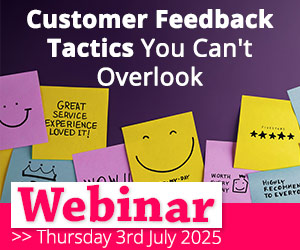Customer experience (CX) tools make it easier for businesses to connect with and learn from their customers.
From social media management to sales automation, these tools can perform several tasks that target customer satisfaction and loyalty.
CallMiner have collected advice from CX experts regarding how to use various customer experience tools to improve satisfaction and loyalty, including:
- Using usability testing to discover customer pain points
- Leveraging social listening tools to learn how customers really feel about your brand
- Following the customer journey with mapping tools
- Storing customer data in a way that’s accessible to all teams
In this article, you’ll learn:
- What customer experience tools do for satisfaction and loyalty
- 25 ways customer experience tools boost satisfaction and loyalty
- Frequently asked questions
What CX Tools Do for Satisfaction and Loyalty
Customer experience tools do a lot behind the scenes to provide a company with insight into how happy its customers are with its products, services, or overall brand.
CX tools gather data in real time, like phone conversations with customers or brand mentions on social media, and analyze those interactions to report on customer behavior, predict churn, and more.
With the right customer experience tools in place, brands can monitor their image and get the data they need to improve their products, services, and customer experiences.
25 Ways CX Tools Boost Satisfaction and Loyalty
1. Software With Real-Time Guidance Improves Agent Performance
“Real-time guidance uses artificial intelligence (AI) and machine learning (ML) to monitor conversations, most often between customers and customer service agents in the contact centre.
Based on pre-determined parameters, such as scripting compliance, customer statements or competitive mentions, real-time alerts can help agents more effectively navigate through customer interactions.
The right tools also enable supervisors to monitor agent performance, empowering them to support agents through conversations, such as escalations, as needed.” – CallMiner
2. AI Tools Are the Future of CX
“According to respondents, chatbots and AI (often used in tandem) have been the most impactful of the newer technologies used in building customer loyalty.
These will remain investment priorities in coming years, while companies in sectors such as financial services, retail and media will also prioritize spending on augmented reality (AR) in their efforts to enrich the customer experience.” – Verizon Business
3. Evaluate and Compare CX Tools to Find the Best Solution
“When assessing experience management software options, approach evaluations like chess moves rather than simple feature checklists.
Plot out current process gaps through customer journey mapping to identify priorities – whether improving response times, adding channels, or increasing personalization.
Research how prospective software options address these priorities while aligning with CX strategies around driving loyalty and brand affinity.
Look beyond basic functionality and focus on implementation factors like flexibility across pricing models, scalability to meet demands, standout features, integration complexity, and data transparency.” – T-ROC
4. CX Software Works Best With Ample Datasets
“Your CX software’s potential is only as good as the data you feed it. Gather data from multiple sources, including surveys, customer interactions, and feedback.
Ensure data quality and accuracy. Regularly update customer profiles with the latest information to maintain relevance.
Modern CX software often integrates with Customer Relationship Management (CRM) systems to streamline data collection.” – Faye
5. Usability Testing Software Lets You Get Real-Time Feedback About User Pain Points
“Usability testing is done by real-life users who are likely to reveal issues that people familiar with a website can no longer identify – very often, in-depth knowledge makes it easy for designers, marketers, and product owners to miss a website’s usability issues.
Bringing in new users to test your site and/or observing how real people are already using it are effective ways to determine whether your visitors:
- Understand how your site works and don’t get ‘lost’ or confused
- Can complete the main actions they need to
- Don’t encounter usability issues or bugs
- Have a functional and efficient experience
- Notice any other usability problems
This type of user research is exceptionally important with new products or new design updates: without it, you may be stuck with a UX design process that your team members understand, but your target audience will not.” – Hotjar
6. Social Listening Tools Tell You How Customers Really Feel About Your Brand
“Social listening refers to monitoring and analyzing your social media profiles for customer feedback; direct mentions of your brand; and any conversations with relevant keywords, topics, competitors, or industries.
You can use social listening to uncover insights that help determine the best ways to improve your social media strategy, brand perception, positioning, and social presence.” – HubSpot
7. CX Analytics Tools Drill Down Customer Behaviors
“With customer experience analytics, you can make data-driven decisions based on collected customer data. You can see and understand why customers behave in a particular way and what their current needs are.
This will help you prioritize bug fixing, feature updates, and big product tweaks, considering potential revenue growth from each improvement.” – Userpilot
8. Choose Software With Customer Segmentation for Better Results
“Segmentation enables you to target specific customer groups with tailored experiences. Use your CX software to categorize customers based on demographics, behavior, and preferences.
This allows you to customize your approach and offers. For example, segment your email marketing campaigns to deliver content that resonates with different customer segments.” – Faye
9. Leverage Data to Customize Loyalty Programs
“Customer loyalty programs are centered around building close, lasting relationships with your brand, which is why personalization is key.
Rather than taking a one-size-fits-all approach that’s generic and impersonal, consider using data to customize messaging and offers for each loyal customer.
For example, if a customer continuously purchases the same product from your brand, you might offer a discount for it in the future.” – Baesman
10. CX Tools Make the Voice of the Customer a Priority
“Companies that embed the voice of the customer into the fiber of their business, gathering feedback everywhere the customer is and delivering it to every employee to close the loop, get far better results than those that do not.
Medallia found that 66 percent of its customers capture multi-channel feedback, which can include email, interactive voice response (IVR), online, mobile, receipts, and social posts — and the trend is growing.
Having the right systems in place to capture customer feedback, deliver tailored insights and prioritize actions to every employee drives measurable improvement.
For example, companies that enable their employees to access customer feedback ‘on-the-go’ via their mobile devices achieve a Net Promoter Score (NPS) 11 points higher on average than companies whose employees don’t.” – IT Business Edge
11. Workflow Management Tools Help Businesses Help Their Customers Quickly
“Generally speaking, you want your customer experience optimization software to make your life easier. So, what you should look for is workflow optimization and management. This includes automatic support ticket creation, instant ticket acknowledgment, and fast problem resolution.” – Podium
12. Customer Retention Software Offers Automation for Increased Loyalty
“Identify repetitive tasks, such as sending follow-up emails or reminders. Choose a customer retention software that offers automation features for these tasks, like scheduling emails or triggering reminders based on customer actions.
Set up rules and conditions within the software to automate the process of identifying at-risk customers or segmenting them for targeted communication. Regularly review and optimize the automated processes to ensure they align with the evolving customer retention strategy.
Incorporating automation into customer retention processes can save time, enhance accuracy, and enable personalized interactions with customers, ultimately fostering stronger relationships.” – Process Street
13. Omnichannel Customer Service Software Provides Consistency Across Channels
“An omnichannel experience is a coordinated journey that stretches across multiple customer touchpoints to deliver a seamless customer experience.
When done correctly, it allows customers to start their journey on one channel and continue on another while receiving a consistent level of support.
This type of strategy considers the customer’s entire journey, from the first point of discovery to after-the-sale support.
It also streamlines the buying process by giving prospects a consistent experience regardless of the channel they’re using.” – Whatfix
14. CRM Software Acts as a Hub for Understanding Customers
“The first step to boosting customer loyalty for franchises is leveraging customer relationship management (CRM) platforms to collect purchase history, contact info, and other relevant data in one centralized hub.
By aggregating information on current customers, especially repeat purchasers and loyalty program members, franchises can identify their highest-value clusters and tailor communications and offers specifically to them.
Personalization is key – 75% of consumers say they’re more likely to buy from brands that understand their unique needs and preferences.
CRM systems empower franchises to send segmented emails, target online ads, and make product recommendations based on each customer’s habits and behaviors.
This personalized approach helps build meaningful digital relationships that inspire customer loyalty for franchises.” – Evocalize
15. Product Experience Tools Can Slide You Ahead of Competitors
“Conversation intelligence technology leverages AI and machine learning to ingest, parse, understand, and obtain insight from the information in text and voice conversations.
For example, your contact centre agents field thousands of calls with customers every day, and each of these interactions can be an invaluable source of unsolicited feedback about your brand and products.
By transforming the rich, unstructured information in these conversations into structured data that can be searched, categorized, and analyzed, conversation intelligence delivers deep insights into your customers’ product experience.
In addition to intelligence about customer preferences, superior product feedback tools can provide teams with deeper competitive insights.
For example, mining conversations for competitor mentions improves understanding of a product’s greatest strengths and weaknesses as it stacks up against competitors’ offerings.
And by combining conversation intelligence information with other data points, your brand and product management teams can help uncover product risks and threats that may not yet be on your radar.” – CallMiner
16. Predictive Analytics Tools Can Help a Company Pinpoint Customer Needs
“One example explored in Business Analytics is casino and hotel operator Caesars Entertainment’s use of predictive analytics to determine venue staffing needs at specific times.
“In entertainment and hospitality, customer influx and outflux depend on various factors, all of which play into how many staff members a venue or hotel needs at a given time.
Overstaffing costs money, and understaffing could result in a bad customer experience, overworked employees, and costly mistakes.
“To predict the number of hotel check-ins on a given day, a team developed a multiple regression model that considered several factors. This model enabled Caesars to staff its hotels and casinos and avoid overstaffing to the best of its ability.” – Harvard Business School Online
17. Centralized Storage Makes Customer Data Available to All Teams
“A good customer experience management solution stores all your customer information in one place, with real-time updates that are easy to share with your various teams.
You should be able to see a history of your interactions with customers from their behavior (such as purchase or contact) to how it made them feel (customer feedback), revealing where you got customer service right, and where you maybe got it wrong.
Your customer experience management solution is a repository of interaction and experience data about each of your customers that makes future interactions smoother, easier, and more personalized.
At the same time, it’s a macro-level data source that helps you see trends and patterns in your business as a whole, across large numbers of customer interactions.” – Qualtrics
18. CX Tools Help Sentiment and Emotion Analysis Work Together
“Emotion motivates people to develop and express their sentiments, but it does not tie into most sentiment analysis workflows as these are designed to rate data at a higher, less detailed level.
According to Forrester, emotion has a bigger impact on brand loyalty and customer retention compared to other metrics that have long been relied on, such as CX effectiveness and customer engagement.
Measuring emotion has many advantages, such as producing more actionable insights and deepening your understanding of customers’ motivations for interacting with or leaving your company.
Emotion goes much deeper than sentiment, allowing your business to make more relevant and data-driven changes to its operations with emotion-derived insights than with those obtained through sentiment analysis.
For instance, where sentiment analysis would reveal a comment regarding your brand on social media to be positive or negative, emotional analysis would strive to determine how the poster was actually feeling when they mentioned your brand in the first place.
This key difference makes the addition of emotional context particularly appealing to businesses looking to create more positive customer experiences across touchpoints.” – CallMiner
19. NPS Can Be a Valuable Metric for Customer Loyalty, But It Shouldn’t Be Used Alone
“NPS is an indicator. It provides an overall metric to track and allows you to monitor product, service or organization improvements. But there is so much that influences NPS.
As such, it’s important to think of NPS as part of an ongoing process of improvement. The customer experience that dictates NPS scores is made up of a huge number of touch points, interactions and channels – digital and physical, during pre-purchase and in post-sale customer support.
Every time you run an NPS survey and calculate your score, you have an opportunity to measure against past performance and work out how you can improve things for next time.
But because NPS is the signal, rather than the source, that means collecting other data sets around the customer experience.
Contact centre software and customer experience management software can help here; you’re looking for tools that can analyze interactions across channels and highlight trends.
If customers are having to make repeated contact about the same issue, for example, you’ll know that something needs to be fixed along the customer journey.” – Qualtrics
20. Cloud Services Create Better Digital Experiences for Customers
“Mobile app glitches, slow website performance, or clunky user interfaces on digital platforms can frustrate customers and sink a company’s credibility, and these are only a few of the many ways underperforming technology can undermine a company’s CX efforts.
Technologies such as scalable cloud infrastructure, multicloud computing environments, and cloud integration services help companies manage the mix of apps and data needed to effectively orchestrate a seamless digital experience for customers.” – Oracle
21. Customer Journey Mapping Tools Detect Potential Problems Every Step of the Way
“No matter the customer experience, there is always a back-and-forth exchange between a customer and at least one other interaction point.
This exchange can happen directly through a user interface on a webpage, through technology and infrastructure that acts behind the scenes, or when another human gets involved.
In most cases, there are touchpoints you’re not immediately aware of until you take the time to view the entire customer experience as one end-to-end view.
These are often hidden problems, such as workarounds to treat a symptom rather than solve a root cause.
Look at these interaction points to see which are working as expected, which are temporary fixes, and which are choke points or even outright roadblocks.” – Forbes
22. Connect Loyalty Software With Other CX Tools for the Best Results
“Your customer loyalty software should play nice with your existing operating systems. Especially your CRM, CMS, POS, and social media.
For example: If you offer loyalty cards through a brick-and-mortar business, tracking is way more efficient if the customer data automatically transfers to your loyalty program software when the card is scanned at checkout. Think about if a customer accrued points with the purchase or redeemed a reward.
Integrations help you streamline customer loyalty programs across the different elements of your business model – and reduce the margin of error.” – HubSpot
23. AI Chatbots Have Become the Next Best Thing to Live Agents
“AI-powered chatbots can provide 24/7 customer service support as an always-available channel for questions, feedback or issues resolution.
Bots can also make recommendations on items to order based on past purchase patterns or suggest new products to try based on demonstrated flavors/attributes the customer has enjoyed before.
Over time the bot’s suggestions become increasingly dialed into individual preferences thanks to machine learning.” – Evocalize
24. Technology Is There to Enhance Loyalty Programs
“Having the right technologies can ease participation in your loyalty program (sign-ups, rewards redemption). They can enable streamlined omnichannel experiences, focusing on mobile to traditional in-store.
This allows members to interact with your brand across all channels, presenting the opportunity to track customer activity to leverage for targeted campaigns.
Also, smart and emerging technologies like artificial intelligence (AI) and machine learning (ML) can do everything from analyze large amounts of data to help expand your brand to virtual worlds to create gamification programs, unlocking new and exciting experiences and special moments for members – thus increasing overall engagement.” – EY
25. Exploring New Technologies Is Often Beneficial for Companies and Customers
“Our exploration of technologies has helped in a few ways. First, giving our people access to the right tools to do their jobs boosts their engagement and expertise, which means happier customers.
Second, technology allows us to do things in more efficient, innovative ways and create bespoke solutions and value for our customers. Our customers see this and know we will adapt to meet their needs.” – Blu Ivy Group
Frequently Asked Questions
What Is a CX Tool?
Customer experience (CX) tools help businesses learn more about or cater to their customers’ needs. Different CX tools can perform various tasks, from gathering data from customer feedback to managing a company’s loyalty programs.
What Are Some Different Types of CX Tools?
Several types of CX tools help businesses complete different tasks, such as managing customer feedback across multiple channels and managing the business’s content.
Data collection, loyalty management, and customer journey mapping software are also types of CX tools.
How Can CX Tools Improve Satisfaction and Loyalty?
CX tools collect and analyze customer data, allowing businesses to see what they can improve upon to make the customer experience better, therefore boosting customer satisfaction and loyalty.
CX tools also offer management features to keep businesses’ customer relationship management processes organized.
This blog post has been re-published by kind permission of CallMiner – View the Original Article
For more information about CallMiner - visit the CallMiner Website
Call Centre Helper is not responsible for the content of these guest blog posts. The opinions expressed in this article are those of the author, and do not necessarily reflect those of Call Centre Helper.
Author: CallMiner
Reviewed by: Xander Freeman
Published On: 27th Jun 2024 - Last modified: 22nd Oct 2024
Read more about - Guest Blogs, CallMiner






 CallMiner is the leading cloud-based customer interaction analytics solution for extracting business intelligence and improving agent performance across all contact channels.
CallMiner is the leading cloud-based customer interaction analytics solution for extracting business intelligence and improving agent performance across all contact channels. 












